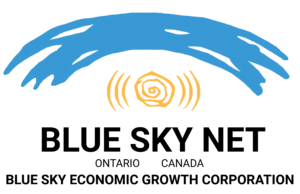State Of Broadband In Northern Ontario – 2023
NORTH BAY, ONTARIO, May 31, 2023 –
The Federal Government of Canada and the Ontario
Provincial Government understand the importance of high-quality internet access. In fact, both have
set a target for 50/10Mbps internet access – the Federal Government aiming for every household by
2030 and the Province of Ontario for every Ontario household by 2025. Although the Federal
Government currently states that as of 2021, 91% of Canadian households had access to Fixed
high-speed internet, a recent report by Auditor General Karen Hogan found that there was a
significant digital divide between rural and remote communities and larger urban centres. In the
auditor general’s report, they found that rural and remote communities were currently at 59.5%
high-speed internet access.
Where does Northern Ontario Fit into this Picture?
Blue Sky Net recently completed a study reviewing where Northern Ontario currently fits in when it
comes to high-speed internet access and has published the Northern Ontario Broadband Report.
Using the latest available data from the Federal Government, Blue Sky Net has found that of the
285 Northern Ontario communities, only 74 had at least 50% of their households able to access
50/10Mbps fixed high-speed internet. Of those 74 communities, only 47 had at least 75% of
households accessing 50/10Mbps internet.
The study also found that smaller communities in Northern Ontario felt the impact of this digital
divide the hardest. According to Census Canada, of the 285 Northern Ontario Communities, 187 had
populations under 1,000 and only 41 of these communities had at least 50% of their households able
to access 50/10Mbps internet.
Northern Ontarian Speed Test Results
Blue Sky Net has been partnering with the Canadian Internet Registration Authority (CIRA) to conduct speed tests throughout Northern Ontario to better understand the broadband landscape. Between 2020-2022, 31,895 speed tests were recorded and throughout that time it was found that the median speed test result improved from 4.88Mbps (download speed) to 20.21Mbps in 2022. Although these speed tests can be taken by cell-phone and satellite internet users, this shows a somewhat positive trend towards improved broadband in Northern Ontario.
Challenges in Developing Broadband Networks
Northern Ontario is a vibrant and diverse region with spectacular natural terrain that rests on the Canadian Shield. However, those natural features that make Northern Ontario unique and beautiful also presents challenges in developing broadband networks. The tough bedrock, hilled regions, lakes and long distances between communities presents financial barriers for private network expansion where the potential return on investment is strained. Further, a “one-shoe-fits-all” approach to internet technologies may not work because of Northern Ontario’s diverse topography.
Optimism for the Future
The Northern Ontario Broadband report demonstrates a gradual improvement in broadband access throughout Northern Ontario. Presently there are 73 recently completed, announced or in-progress broadband projects throughout the North. We anticipate this improvement will continue as both the Federal and Provincial governments continue to invest in broadband projects that help facilitate network expansion in areas where internet service providers have a difficult business case.
To read the full Northern Ontario Broadband Report, please visit: www.connectednorth.ca/northern-ontario-broadband-report-2023
Resources for Northern Ontario broadband mapping, research and learning can be found at:
-30-
Susan Church
Executive Director
Blue Sky Economic Growth Corporation
1-705-476-0874 ext: 211
About Blue Sky Net:
Blue Sky Net (Blue Sky Economic Growth Corporation) is a not-for-profit organization located in North Bay since 2002. Our mission has been to promote the development and adoption of digital technologies. Blue Sky Net operates the connectednorth.ca website, Ontario Internet Access Map (OIAM) and the Broadband and Associated Infrastructure Analysis Project (BAIMAP).
